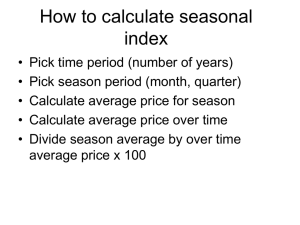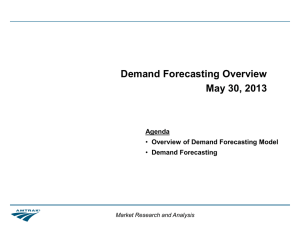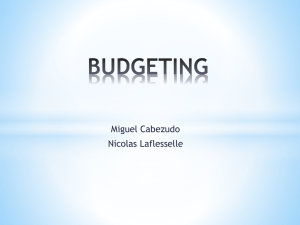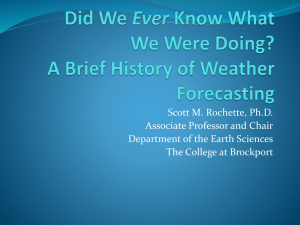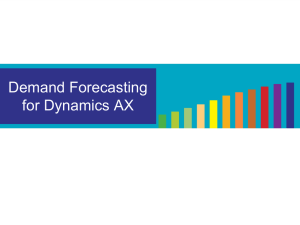A Wood, Seasonal streamflow forecasting and water management
advertisement
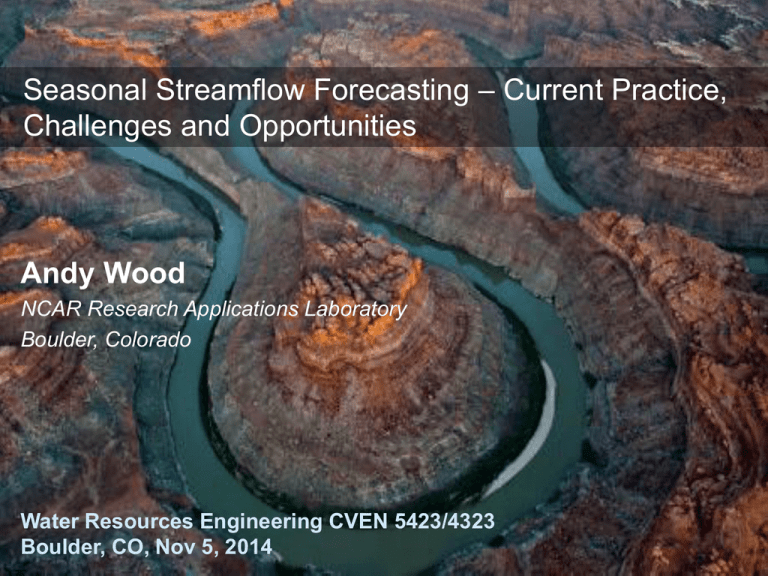
Seasonal Streamflow Forecasting – Current Practice, Challenges and Opportunities Andy Wood NCAR Research Applications Laboratory Boulder, Colorado Water Resources Engineering CVEN 5423/4323 Boulder, CO, Nov 5, 2014 1 Outline • Water Management in the western US • Operational Forecasting – objectives – decisionmaking • Hydrologic Predictability • Opportunities for Improvement The Arid Lands Many droughts will occur; many seasons in a long series will be fruitless; and it may be doubted whether, on the whole, agriculture will prove remunerative. John Wesley Powell, 1879 Report on the lands of the arid region of the United States ‘water supply forecasts’ 1-12, even 24 months large reservoirs NCAR statistical/ESP Boulder, Colorado ‘runoff outlooks’ 1-3 months smaller reservoirs ESP Precipitation, 1971-2000 3 Colorado River 25 million people in 7 states rely on Colorado River water 3.5 million acres of irrigation 85% of runoff comes from above 9000 feet Mean annual discharge is … (?) Storage capacity is about 60 MAF (4-5 times mean annual flow) Stakeholder Example Metropolitan Water District (California) • Supplies water to ~20m residents in southern California (including L.A.) • Issues weekly water supply conditions map (right) based on RFC, CA DWR, and NRCS forecasts and data 5 Colorado Basin River Forecast Center Thirteen River Forecast Centers Established in the 1940s for water supply forecasting Three primary missions: 1. Seasonal Water supply forecasts for water management 2. Daily forecasts for flood, recreation, water management 3. Flash flood warning support Value Damage from 1/10 AZ storm: Damage from 6/10 UT flooding: Damage from 12/10 UT/NV storm: Damage from 09/13 Boulder flood: $11ma $6.5ma $11ma $1bc Colorado River average runoff: 12.4 MAF Replacement value of $330/AF -> $4bb Economic value of water resources far greater than flooding damages Sources: a: WFO, FEMA (via stormdata); b: MWD (via Hasencamp, private communication) c: Wikipedia i7 Water allocations 8 Water allocations 1944 -- Mexican Water Treaty allocated Mexico 1.5 MAF 1928 -- Boulder Canyon Project first allocated water among lower basin states … 1964 -- It was disputed by states until Act that cleared way for Central AZ Project 9 • By law, 16.5 MAF can be taken from river • values for inflow depend on method of calculation What IS the flow of the Colorado River? 13.2 MAF/YR H. G. Hidalgo, T. C. Piechota, and J. A. Dracup, 2000: Alternative principal components regression procedures for dentrohydrological reconstructions, WRR v. 36, p. 3241-3249 13.5 MAF/YR C. W. Stockton and G. C. Jacoby, 1976: Long-term surface-water supply and streamflow trends in the Upper Colorado River Basin. Lake Powell Res. Proj. Bulletin no 18, NSF 14.3 MAF/YR C. A. Woodhouse, S. T. Gray, and D. M. Meko, 2005: Updated streamflow reconstructions for the Upper Colorado River Basin, WRR v. 42, W05415, doi:10.1029/2005/WR004455, 2006 http://treeflow.info/upco/colo radoleesmeko.html Lake Mead Elevation 1935 1975 2010 12 Recent drought has increased interest in forecasts Colorado River Allocation Law responds • Interim “Shortage Sharing” Guidelines (2007) – rules now in force through 2026 that are tied to NWS CBRFC forecasts Key facts: River is over-allocated: original allocation (16.5 MAF) was based on a series of wet years Lower basin states (AZ, CA, NV) use full 7.5 MAF each year Mexico uses its full 1.5 MAF Upper basin states (CO, WY, UT, NM) are still “developing” their 7.5 MAF No shortage has ever been declared on the river Shortages would affect lower basin states first (and AZ first of all) Management using CBRFC Flow Forecasts Upper Colorado Reservoir Management Water transfer from upper to lower basin states depends on forecast Major releasesdecision depend on CBRFC April 1 Forecasts 3,635 1/1/10 Projection 15.4 1/1/010Proj ection 1,098 1/1/10 Projection 11.4 1/1/10 Projection 15 Management Challenges infrastructure constraints not always in line with legal objectives outage Management Challenges Management Challenges a forecast Management using CBRFC Flow Forecasts Upper Colorado Reservoir Management 4,035 cfs Mar 15 Forecast 570 KAF 19 How are forecasts created? Water Supply Forecast Methods Statistical Forecasting Statistical Regression Equations Primary NOAA/RFC forecast method from 1940’s to mid 1990’s. Primary NRCS/NWCC forecast method Historical Relationships between flow, snow, & precipitation (1971-2000) Tied to a fixed runoff period (inflexible) Ensemble Simulation Model Forecasting A component of a continuous conceptual model (NWSRFS) Continuous real time inputs (temperature, precipitation, forecasts) Accounts for soil moisture states (SAC-SMA) - drives runoff efficiency Builds and melts snowpack (Snow-17) – output feeds SAC-SMA Flexible run date, forecast period, forecast parameters. Evolving toward ESP as primary forecast tool at NOAA/RFCs Statistical Forecast Equations: Trial Lake SNOTEL Predictor variables must make sense Challenge when few observation sites exist within river basin Challenge when measurement sites are relatively young Fall & Spring precipitation is frequently used (why?) Sample Equation for April 1: April-July volume Weber @ Oakley = + 3.50 * Apr 1st Smith & Morehouse (SMMU1) Snow Water Equivalent + 1.66 * Apr 1st Trial Lake (TRLU1) Snow Water Equivalent + 2.40 * Apr 1st Chalk Creek #1 (CHCU1) Snow Water Equivalent - 28.27 Source: NRCS NWS Community Hydrologic Prediction System New modeling structure at all RFCs • New wrapper for old models…but... • Facilitates research to operations • gives more insight into the model used Transition completed in 2011 NWS River Forecast Process Weather and Climate Forecasts Hydrologic Model Analysis hydrologic expertise & judgment Forecast precip / temp model guidance River Forecast Modeling System Analysis & Quality Control Observed Data Outputs Graphics parameters Calibration River Forecasts Rules, values, other factors, politics Decisions Data Processing • • • • • • Data collection collation Data assimilation Quality control Forcing construction (HAS) Forecast Review Observed forcings Precipitation + Temperature + Freezing level + ET • • • • • • Modeling • • • • • • Dissemination • • • • • • Model simulations Hydrologic analysis Hydraulic analysis Bias & error adjustments Regulation Integration Collaboration MPE Multi-Precip Estimator MM Mountain Mapper Daily QC Process methods vary Interactive Processes Threshold and spatial comparisons Systematic estimation Manual forcing and over-rides Hourly and max/min data (temperature) Quality Control (QC) and processing procedures vary by region and RFC Interactive methods GFE Output qualified for model use Gridded Forecast Editor Slide by H. Opitz, NWRFC Forecast generation Quality assurance Dissemination Web services Coordination & collaboration Basin monitoring & review National Center Support Forecast Forcings WFO Weather Forecast Office National Model Guidance National Model guidance available to WFO & RFC WFO & RFC directly share gridded forecasts via GFE exchange Grids at 4km or 2.5km GFE Gridded Forecast Editor RFC River Forecast Center Slide by H. Opitz, NWRFC RFCs employ grid and point forcings to hydrologic model Point or gridded data converted to mean areal forcings Data Assimilation • • • • • Data collation Data assimilation Quality control Forcing construction (HAS) Forecast Review Modeling • • • • • • Model simulations Hydrologic analysis Hydraulic analysis Bias & error adjustments Regulation Integration Collaboration NWS: Streamflow Forecasting is an iterative & interactive process Analysis & Assessment Bias adjustments and error corrections Dissemination • • • • • • Forecast generation Quality assurance Dissemination Web services Coordination & collaboration Basin monitoring & review Also: SNOW-17 Temperature index model for simulating snowpack accumulation and melt Simulation and Analysis Observed Hydrology Sacramento Soil Moisture Accounting Model Slide by H. Opitz, NWRFC Streamflow Prediction Challenges: forecast future weather (hours to seasons) Past Historical Data e.g., SNOW-17 / SAC Historical Simulation Future Forecasts SNOW-17 / SAC SWE SM Q General State of Practice • conduct ensemble simulation at fine-time step (e.g., sub-daily); aggregate to client needs (e.g., daily to seasonal information) • adjust results to compensate for known model biases (practice varies) Fig. M. Clark (NCAR) Runtime Modifications River Forecast Centers • • • MOD capability has been available in the NWS >30 years Generic MOD capability implemented within FEWS Extend capability to other users outside of OHDcore models Slide by H. Opitz, NWRFC Calibration Climatology CHPS Observed and Simulated not Tracking MOD Interface Result: Improved observed period simulation Hydrologist render a Run-Time modification to the SACSMA Model and increases the lower zone primary and supplemental states Examples: Nooksack R Typical situation during snowmelt: the simulation goes awry What can a hydrologist deduce from this simulation? As it is, blending simulation and obs gives an ‘unrealistic’ forecast 30 Examples: Nooksack R One Solution -- Double the snowpack (WECHNG) Other approaches may also have been tried: lower temperatures, raise soil moisture, etc. 31 Examples: Nooksack R The resulting simulation is better, hence the forecast is more confident Flows stay elevated, have diurnal signal of continued melt. 32 A manual, subjective process Manual elements Meteorological analysis Quality control of station data Quality control of radar and radar parameters WFO+HPC met. forecast Water Supply Forecast Hydrologic simulation and flood forecasting Daily Flood Forecast Process Long-lead forecasting Coordination with USDA/NRCS WFO forecast itself (though based on models) RFC merge with HPC forecast (similar to WFO) Sac./Snow17 model states and parameters Bias-adjustment relative to obs. Flow Input forcings (2nd chance at adjustment) Model states as adjusted for flood forecasting Choice of models (statistical / ESP ) Blend of models Choice of meteorology: QPF, ENSO, None? Merging with NRCS statistical forecasts means, confidence limits (“10-90s”) 33 ESP example -- Feb 1 forecast Feb 1 Future Medium chance of this level snow or higher Sno w Past Low chance of this level snow or higher High chance of this level snow or higher Time • ESP forecasts based on • (1) initial conditions (e.g. snow pack, base flow, etc) • (2) historical meteorological scenarios ©The COMET Program Mar 1 forecast Mar 1 Future Medium chance of this level flow or higher Sno w Past Low chance of this level flow or higher High chance of this level flow or higher Time ©The COMET Program Apr 1 forecast Medium chance of this level snow or higher High chance of this level snow or higher Sno w Past Apr 1 Future Low chance of this level snow or higher Time ©The COMET Program Forecasts and Water Management CBRFC ensemble flow forecasts for Reclamation water management Average contribution to Lake Powell Apr-Jul inflow: Green RiverStakeholder 34% Reclamation Allocations Colorado River 50% MidtermSan Juan River 13% Probabilistic Model Graphic from Dr. Katrina Grantz, Bureau of Reclamation 37 37 Seasonal streamflow prediction is critical One example: Met. Water Dist. of S. California (MWD) MWD gets: Surplus 1.25 MAF OR 0.55 MAF +$150M gap from B. Hazencamp, MWD ? 38 Water supply forecasting Both frameworks can be skillful ESP – model-based PCR - statistical Yet both have drawbacks • raw ESP: fails to account fully for hydrologic uncertainty • may have bias • overconfident • PCR, ie, flow = f(SWE, acc. PCP) • cannot provide confidence bounds (heteroskedastic error) in many places • small samples • used since mid-1990s • Ad-hoc combination What are the sources of seasonal streamflow predictability? Opportunities for prediction hydrological predictability meteorological predictability Hydrological Prediction: How well can we estimate the amount of water stored? Accuracy in precipitation estimates Fidelity of hydro model simulations Effectiveness of hydrologic data assimilation methods Meteorological predictability: How well can we forecast the weather? Opportunities: Which area has most potential for different applications? Water Cycle (from NASA) A western US water cycle Runoff = Precip – ET – ΔSM - ΔSWE October April September water depth SWE SM Precip Evap Runoff water year Seasonal Variation in Predictor Importance Assessing the sources of flow forecast skill w=0.5 http://www.ral.ucar.edu/staff/wood/weights/ w=0.5 Snow-Driven Basin in the Western US • Wide seasonal variations in influence of different skill sources • cold and dry forecast period forecast skill depends strongly on initial condition influences • warm and wet forecast period forecast skill depends strongly on met. forecast skill opportunities for improvement Improved SCFs through Climate Prediction Conditioned on IRI seasonal forecast Get the prediction (A:N:B=40:35:25) Divide historical sequencies into 3 tercile categories Bootstrap 40, 35 and 25 sample of historical years from wet, normal and dry categories Apply the ensembles in ESP instead of historical weather sequences (from Balaji Rajagopalan, CU) CFSv2 precipitation forecast skill • For seasonal time scales, skill is lower • some seasons may have better skill, varying little across leads East R at Almont, Co, precip 43 Improved Human Resources The forecasting and water management enterprise needs people with a strengths in: • • • • • • watershed science land surface modeling atmospheric and/or climate science probability and statistics objective analysis (time-series, spatial) programming (UNIX, R, Python, ‘traditional’, web, database) • technical communication • systems engineering • water resources planning, management and policy 50 Questions? Questions? Dr. Andy Wood CBRFC Development and Operations Andy.Wood@noaa.gov http://en.wikipedia.org/wiki/Lake_Powell Abstract Seasonal Streamflow Forecasting - Current Practice, Challenges and Opportunities Several US agencies are charged with operationally producing seasonal streamflow forecasts, which are a critical input to water management throughout the US, and particularly in the western US, where flood-prone winters and dry summers necessitate careful decision-making over water allocation and use. Water supply forecasts (WSFs) that predict the volume of snowmelt-driven runoff in the spring and early summer, for example, are a critical product informing the regulation of major storage projects such as Lakes Powell and Mead. This presentation focuses on the tradition of water supply forecasting and describes an approach for diagnosing the sources of prediction skill. The talk will also highlight strengths and weaknesses of the current practice and suggest potential methodological opportunities for WSF improvement. Improved IHCs through modeling 53 Snow Distribution – corroborates presence of lower elevation snow in 2010 at start of melt 2010 June 1 2006 Snowbird SNOTEL trace almost identical to 2010 trace from June 1-10 However, NOHRSC indicates south facing slopes had already melted out in 2006 2006 June 1 SNOW17 SWE 55 Distributed SWE (eg SNODAS, use of MODIS SCA) 56 Improved post-processing • Statistical post-processing of forecasts can correct systematic bias and spread problems (particularly ESP overconfidence and bias). • Require long track record of consistent forecasts for training • Would need to change the current operational ESP approach April 1 Forecast of April-July streamflow volume, North Fork Gunnison (SOMC2) 90th 50th 10th Rain-Driven Basin in the Southeastern US • For 6-month forecast, seasonal variation in flow forecast skill sensitivities (met. forecast or IC) is minimal • Effectiveness of skillful met. forecasts diminishes if initial conditions are not well-captured day-to-day changes in seasonal flow forecasts • water managers / traders don’t like rapid changes in seasonal forecasts • at least, causes should be explicit ?! 1-day change in median ESP forecast (period Apr-July) bars = no weather forecast (mostly state changes) lines = 3 and 10 day weather forecasts included in ESP • sudden changes can come from: • storm hits basin (rise in forecast) • change in short range weather forecasts • forecaster modification to states (or auto-DA) (clear) (less clear) (hidden)

